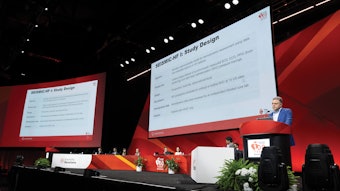LBS 08: Advances in lipid therapeutics
Small-interfering RNA reduced Lp(a) levels, an oral disruptor of Lp(a) synthesis in the liver and selective cholesteryl ester transfer protein.

Monday’s Late-Breaking Science session “New Targets and New Treatments: Advances in Lipid Therapeutics” found that:
- Zerlasiran shows greater than 80% time-averaged reduction in lipoprotein(a) with minimal side effects.
- Muvalaplin, the first oral Lp(a) disruptor, showed positive results.
- CTEP inhibitor reduced LDL-C in individuals with heterozygous familial hypercholesterolemia.
Zerlasiran, a small-interfering RNA (si-RNA), reduced lipoprotein(a) [(Lp(a)] levels by more than 80% at three doses tested in the phase II ALPACAR trial. Maximum Lp(a) reduction was 79.2% while LDL cholesterol fell by 24%-28% over 60 weeks. There were no major safety or tolerability concerns at any of the doses tested.
“Lipoprotein(a) substantially increases the risk of atherosclerotic cardiovascular disease,” said Steven E. Nissen, MD, MACC, chief academic officer at the Heart, Vascular and Thoracic Institute of the Cleveland Clinic Coordinating Center for Clinical Research. “About 20% of the world population, 1.4 billion people, have this disorder, which is historically untreatable because levels are primarily determined by LPA gene. We can best tackle this disease by interrupting the production of lipoprotein(a) in the liver. These (si-RNA) drugs are inherently safe because they do only one thing: They knock out the messenger RNA for a very specific protein, apolipoprotein (a), the rate-limiting step in the production of lipoprotein(a) particles.” Steven E. Nissen, MD, MACC
Steven E. Nissen, MD, MACC
ALPACAR tested three doses of zerlasiran, 450 mg every 24 weeks for 2 doses (45 patients), 300 mg every 16 weeks for 3 doses (42 patients) and 300 mg every 24 weeks for 2 doses (44 patients) versus placebo (47 patients). The mean age was 63.7 years, 25.8% were female, and about 80% self-identified as white. Race and ethnicity are vital, Nissen said. Lp(a) serum concentrations varies by ancestry and are higher in individuals with sub-Saharan background.
The primary endpoint was time-averaged Lp(a) change from baseline to 36 weeks, including intervals between doses to evaluate both peak and trough drug effects. Secondary endpoints included time-averaged changes in LDL-C as well as time-averaged apolipoprotein B to 60 weeks. Baseline Lp(a) concentration was 213 nmol/L.
Timed-averaged Lp(a) reduction varied depending on the dosage and duration of treatment. The result showed a change of -81.3% for 300mg of drug given every 24 weeks for two doses compared to placebo to -85.6% for 450mg of drug given every 24 weeks for two doses at 36 weeks. At 60 weeks, the mean Lp(a) ranged from -71.87% for 300 mg Q 24 weeks to -79,2% for 300 mg Q 16 weeks. LDL-C reduction ranged from -24.1% for 450 mg Q 24 weeks to 28.7% for 300 mg Q 16 weeks.
The most common treatment-related adverse events were headache, reported by 6.9% to 13.3% of patients, and nasopharyngitis, reported by 7.1% to 13.6% of patients in the zerlasiran arms. There were no serious adverse events deemed related to the study drug and 3 events leading to withdrawal.
“Because of the long duration of drug effect, we may not have administered enough doses to reach steady state lipoprotein(a) levels, which may be lower than we observed because we saw a cumulative effect from each successive dose,” Nissen said. “Emerging therapies for elevation of lipoprotein(a), including RNA interference, represent a highly promising approach for management of increased lipoprotein(a). If current trials demonstrate a reduction in morbidity/mortality, identification and treatment of these patients will become a critical public health priority.”
The trial was published simultaneously in Journal of the American Medical Association.
Oral muvalaplin reduces Lp(a) in phase II trial
Muvalaplin, an oral disruptor of lipoprotein (a) [Lp(a)] synthesis in the liver, reduced plasma concentrations of Lp(a) by up to 70% using traditional assays and up to 85.8% using a novel assay in in the phase II KRAKEN trial. The agent also reduced oxidized phospholipid levels up to 73% with no safety or tolerability concerns noted during the trial.
Lp(a) is produced by bonding between apolipoprotein (a) [apo(a)] and apo B100 and is associated with atherosclerotic disease and aortic stenosis, said Stephen Nicholls, MD, PhD, professor of cardiology and director of the Victorian Heart Institute at Monash University in Adelaide, Australia. There are currently no therapies approved to lower Lp(a) and most agents in development are RNA-targeted injectables. Stephen Nicholls, MD, PhD
Stephen Nicholls, MD, PhD
“Muvalaplin is the first oral agent that has been developed to lower Lp(a),” Nicholls said. “It’s a disruptor that stops apo(a) and apo B100 from binding.”
Assessing the activity of muvalaplin has been a problem, he continued. Conventional assays measure apo(a), an adequate approach for injectable agents that reduce Lp(a) production. Because muvalaplin blocks apo(a) binding, not production, direct measurement of circulating Lp(a) is a more appropriate assessment. A reassessment of phase I data using the novel assay showed a reduction in Lp(a) of 75%-80%, rather than the 65% reported using conventional measurement.
The KRAKEN trial followed 233 patients across 44 sites in eight countries for 12 weeks. Patients were at least 40 years old with Lp(a) ≥175 nmol/L at high risk for cardiovascular events based on prior coronary artery disease, stroke, peripheral arterial disease, familial hypercholesterolemia or type 2 diabetes. Participants were randomized to receive muvalaplin 10mg, 60mg, 240 mg or placebo daily for 12 weeks.
The primary endpoint was change in Lp(a) from baseline to week 12. Secondary endpoints included the proportion of patients with Lp(a) ≤125 nmol/L and percent change in Lp(a) from baseline for apo B100 and hsCRP.
“We are showing, for the first time, effects of muvalaplin using the older assay and the new assay,” Nicholls said. “We see very good Lp(a) lowering with both approaches and no noteworthy side effects. And we see a 73% reduction in oxidized phospholipid, one of the factors we think is driving the atherogenicity seen with Lp(a). The big question remaining is, will lowering Lp(a) using muvalaplin reduce the risk of heart attack and stroke? We’ll have to wait for a large outcomes trial to answer that question.”
KRAKEN was published simultaneously in the Journal of the American Medical Association.
Obicetrapib reduced LDL-C for one year in patients with heterozygous familial hypercholesterolemia in BROOKLYN
Many individuals with heterozygous familial hypercholesterolemia (HeFH) are unable to reach and maintain cholesterol targets on maximally tolerated statin therapy. Initial results from the BROOKLYN trial showed the novel selective cholesteryl ester transfer protein (CETP) inhibitor obicetrapib reduced mean LDL-C by -36.3% at day 84 (P<0.0001) and -41.5% at day 365 (p<0.0001) versus placebo. Obicetrapib also reduced apo B by -24.4% and -25.8%, respectively, Lp(a) by -45.9% and -54.3%, and increased HDL-C +138.7% and +121.4%. There were no serious adverse events or clinically significant changes in vital signs, electrocardiograms or other clinical laboratory tests.
“The CETP class was originally developed because the agents were good at raising HDL cholesterol,” said Stephen Nicholls, MD, PhD, professor of cardiology and director of the Victorian Heart Institute at Monash University in Melbourne, Australia. “The early studies didn’t show a lot of promise for a variety of reasons, but we’ve been able to rethink the whole CETP story. The secret sauce for CETP inhibition may lie in its LDL-C lowering more than its HDL-C raising, so obicetrapib was developed as a potent CETP inhibitor.”
BROOKLYN randomized 354 patients across 70 international sites with HeFH and fasting LDL-C ≥70 mg/dL who were already taking maximally tolerated lipid-lowering therapies. Patients were randomized to 10 mg Obicetrapib (236 patients) or placebo (118 patients) daily for 52 weeks.
The primary endpoint was the mean percent change in LDL-C from baseline to week 12. Secondary endpoints included LDL-C change at one year and changes in apo B, non-HDL-C, HDL-C, total cholesterol, Lp(a) and triglycerides at day 84.
Nicholls noted that more than half of patients, 51%, got to LDL-C of <70 mg/dL and 77% got to LDL-C of < 100 mg/dL.
“That’s an important finding because in HeFH, getting to <100 mg/dL for primary prevention is the first target we’re aiming for,” he said. “Nearly four out of five patients got to that target and one in two get lower. “We also saw that obicetrapib reduced Lp(a) levels by more than 50%. That’s a new finding and may add to the clinical potential of this agent. Safety and tolerability looked good, which is important because some of the early CETP inhibitors had issues with regards to safety. Obicetrapib looks well tolerated by patients.
“We’ve been pretty consistently able to demonstrate good lipid effects,” Dr, Nicholls added. “The million-dollar question with the whole class is whether they reduce the risk of clinical events. The PREVAIL study, with around 9,000 patients, will tell us that. We just have to wait a bit longer for the answer.”











